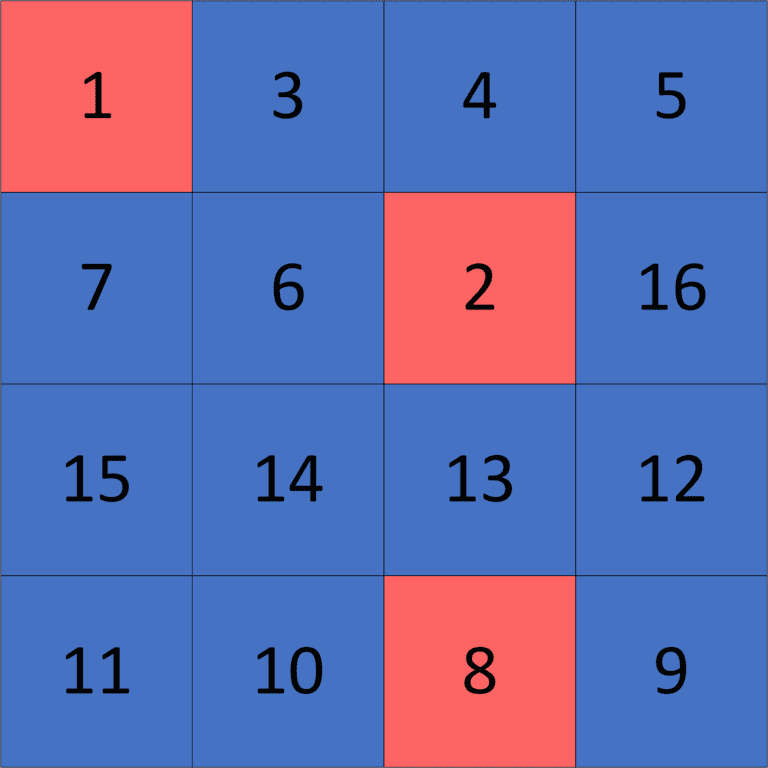1. 概述
本文将探讨如何在一个 N x N 的二维矩阵中寻找局部最小值的问题。
我们将先定义局部最小值的概念,并通过一个示例说明。
然后,我们先介绍一个朴素解法,再改进为更高效的解法。
2. 问题定义
假设我们有一个 N x N 的整数矩阵,每个元素都是唯一的。我们的任务是找出其中任意一个局部最小值。
✅ 局部最小值(Local Minimum):在一个二维矩阵中,一个单元格的值如果小于其所有相邻单元格的值,则该单元格就是局部最小值。
相邻单元格包括上下左右四个方向(如果存在)。
示例
考虑如下 4x4 的矩阵:

其中三个局部最小值分别是:
- (1,1) = 1
- (2,3) = 2
- (4,3) = 8
这些单元格都比它们的相邻单元格小。因此,这三个中的任意一个都可以作为答案。
3. 朴素方法
3.1 思路
核心思想:从任意一个单元格出发,不断向值更小的相邻单元格移动,直到找到一个值小于所有相邻单元格的单元格 —— 也就是局部最小值。
这其实是一个深度优先搜索(DFS)的过程。
3.2 实现
Cell FindLocalMinimumNaive(int N, int[][] M) {
return FindLocalMinimum(new Cell(0, 0));
}
Cell GetNextCell(Cell current, int[][] M) {
int x = current.row;
int y = current.col;
int val = M[x][y];
Cell next = current;
if (x > 0 && M[x - 1][y] < val) {
val = M[x - 1][y];
next = new Cell(x - 1, y);
}
if (y > 0 && M[x][y - 1] < val) {
val = M[x][y - 1];
next = new Cell(x, y - 1);
}
if (x < N - 1 && M[x + 1][y] < val) {
val = M[x + 1][y];
next = new Cell(x + 1, y);
}
if (y < N - 1 && M[x][y + 1] < val) {
val = M[x][y + 1];
next = new Cell(x, y + 1);
}
return next;
}
Cell FindLocalMinimum(Cell current) {
Cell next = GetNextCell(current, M);
if (next.equals(current)) {
return current;
} else {
return FindLocalMinimum(next);
}
}
3.3 时间复杂度分析
- 每个单元格最多被访问一次。
- 每次访问最多检查 4 个相邻单元格。
- 总体复杂度为 **O(N²)**。
4. 分治法(Divide and Conquer)
4.1 思路
核心思想:将矩阵划分为四个象限子矩阵,每次递归地在包含局部最小值的那个子矩阵中查找。
具体步骤如下:
- 找出中间行和中间列中的最小值所在单元格
minCell。 - 找出
minCell的最小相邻单元格nextCell。 - 局部最小值一定在
nextCell所在的子矩阵中。
✅ 为什么这样可以缩小范围?因为中间行/列中最小的那个单元格已经是当前层最小值,如果它还有更小的邻居,说明局部最小值必然存在于那个方向。
4.2 实现
Cell FindLocalMinimumDivideConquer(int[][] M) {
return FindLocalMinimum(M);
}
Cell FindLocalMinimum(int[][] M) {
int n = M.length;
int midRow = n / 2;
int midCol = n / 2;
// 找到中间行和中间列中最小的单元格
Cell minRowCell = getMinInRow(midRow, M);
Cell minColCell = getMinInColumn(midCol, M);
Cell minCell = M[minRowCell.row][minRowCell.col] < M[minColCell.row][minColCell.col] ?
minRowCell : minColCell;
Cell nextCell = GetNextCell(minCell, M);
if (nextCell.equals(minCell)) {
return minCell;
} else if (nextCell.row < midRow) {
if (nextCell.col < midCol) {
return FindLocalMinimum(extractTopLeft(M, midRow, midCol));
} else {
return FindLocalMinimum(extractTopRight(M, midRow, midCol));
}
} else {
if (nextCell.col < midCol) {
return FindLocalMinimum(extractBottomLeft(M, midRow, midCol));
} else {
return FindLocalMinimum(extractBottomRight(M, midRow, midCol));
}
}
}
4.3 时间复杂度分析
- 每次递归处理的矩阵大小是前一次的一半。
- 每次递归需要扫描中间行和列,共约 2N 个单元格。
- 总扫描次数为:
2N + N + N/2 + ... ≈ 4N。
✅ **总时间复杂度为 O(N)**。
5. 总结
| 方法 | 时间复杂度 | 说明 |
|---|---|---|
| 朴素法 | O(N²) | 实现简单,但效率一般 |
| 分治法 | O(N) | 更高效,适合大规模矩阵 |
- 如果只是找一个局部最小值,分治法明显优于 DFS。
- 分治法利用了中间行/列的最小值特性,逐步缩小搜索范围,效率更高。
- 在实际工程中,若矩阵规模较大,建议使用分治法。